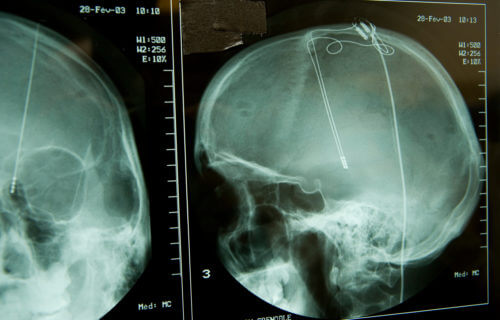BERLIN — Alzheimer’s disease is the most common form of dementia, yet notoriously difficult to treat. Now, a team of scientists in Germany report one potentially effective way to combat Alzheimer’s is deep brain stimulation (DBS) delivered by a pacemaker-like device. Researchers at Charité – Universitätsmedizin Berlin have found that stimulating a specific network within the brains of Alzheimer’s patients reduces dementia symptoms.
Deep brain stimulation is actually already approved as a form of therapy in Germany when it comes to treating neurological movement disorders such as Parkinson’s disease and dystonia, as well as neuropsychiatric diseases like OCD. During a DBS session, very thin electrodes are implanted in the patient’s brain, delivering without interruption mild electrical pulses to a specific region. Those electrodes stay in the individual’s brain permanently, and are connected via wires running under the skin to a pacemaker-like device implanted within the chest. That device is then used to adjust both the strength and frequency of the electrical stimulation.
“Although DBS has been an established treatment for Parkinson’s disease for a good 20 years now, and the costs are covered by health insurance providers, it’s still not a very well-known therapy,” says Prof. Andreas Horn, head of a lab that explores network-based brain stimulation at the Department of Neurology and Experimental Neurology at Campus Charité Mitte, and at Brigham and Women’s Hospital and Massachusetts General Hospital, both affiliates of Harvard Medical School in Boston, in a university release.
“DBS works very well in patients with Parkinson’s,” he adds. “It improves their quality of life significantly.”
Deep brain stimulation revived strong memories from childhood
Considering Alzheimer’s is also a neurodegenerative disease, it makes sense that DBS would be helpful for Alzheimer’s patients. That being said, safe and effective treatments are only possible if the precise brain regions that require stimulation are known.
This project, which was conducted in close collaboration with multiple partners including the University of Toronto, began with a random observation made during a Canadian study.
“In one patient, who was being treated for obesity, deep brain stimulation caused flashbacks – sudden memories of their childhood and adolescence,” explains lead study author Dr. Ana Sofía Ríos from the Department of Neurology and Experimental Neurology at Campus Charité Mitte. “This led the Canadian researchers to suspect that stimulating this brain region, which was located in the fornix, might also be suitable for treating Alzheimer’s.”
So, to investigate further, scientists stationed at seven international centers as part of a multicenter study implanted electrodes in the same area of the fornix among a group of patients with mild Alzheimer’s disease.
“Unfortunately, most patients showed no improvement in their symptoms. But a handful of participants benefited considerably from the treatment,” Dr. Ríos notes. “In the present study, we wanted to find the root cause of these differences, so we compared the exact position of the electrodes in each participant.”
‘DBS very promising’ as effective Alzheimer’s therapy
Prof. Horn’s research group specializes in analyzing high-resolution magnetic resonance images of the brain and then combining those images with computer models in order to precisely pinpoint the optimal locations for DBS treatments.
“One of the main challenges is that every brain is different – and that’s really important for accurately planting the electrodes,” Prof. Horn comments. “When electrodes are placed even a few millimeters off target, it could lead to a lack of benefit for the patient.”
That’s exactly what happened to most of the study participants. However, researchers were able to use the imaging data and identify the exact position of the electrodes in the patients that did benefit from the treatment. “The optimal stimulation site seems to be the intersection of two fiber bundles – the fornix and stria terminalis – that connect regions deep in the brain. Both structures have been linked to memory function,” Prof. Horn says.
Further clinical studies are warranted before DBS can be formally approved and used to treat Alzheimer’s disease, study authors stress. Still, these findings are an important next step.
“If our data make it possible to place electrodes more precisely in neurosurgical studies trialing DBS in Alzheimer’s patients, that would be fantastic,” Prof. Horn concludes. “We desperately need an effective therapy that alleviates the symptoms of this disease – and DBS is very promising.”
Next, the Horn laboratory plans on conducting more studies analyzing and defining additional neural networks in the brain that could be useful in treating dementia. That work will include assessing brain lesion areas and identifying target regions for both DBS and other neuro-stimulation methods.
The study is published in Nature Communications.

I’m an Alzheimer’s patient who received DBS for Alzheimer’s September 2022 at University Texas Health in San Antonio. I do not know if the stimulation has been turned on but I seem to be cognizant most of the time. At the end of the year the DBS will be turned on for certain. Hopefully, it’s working for me now or perhaps the stimulation will begin in September and I will be normal again.